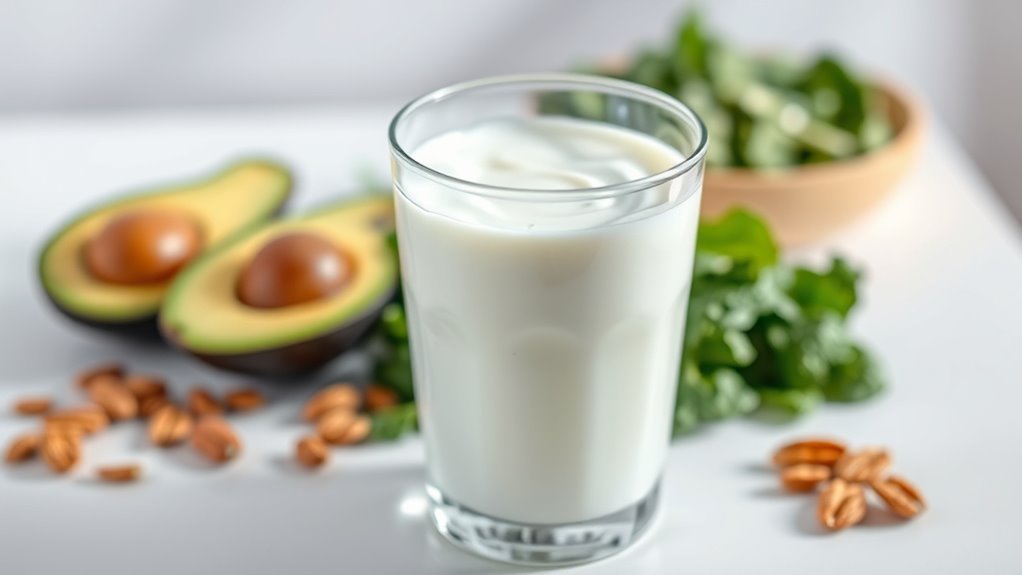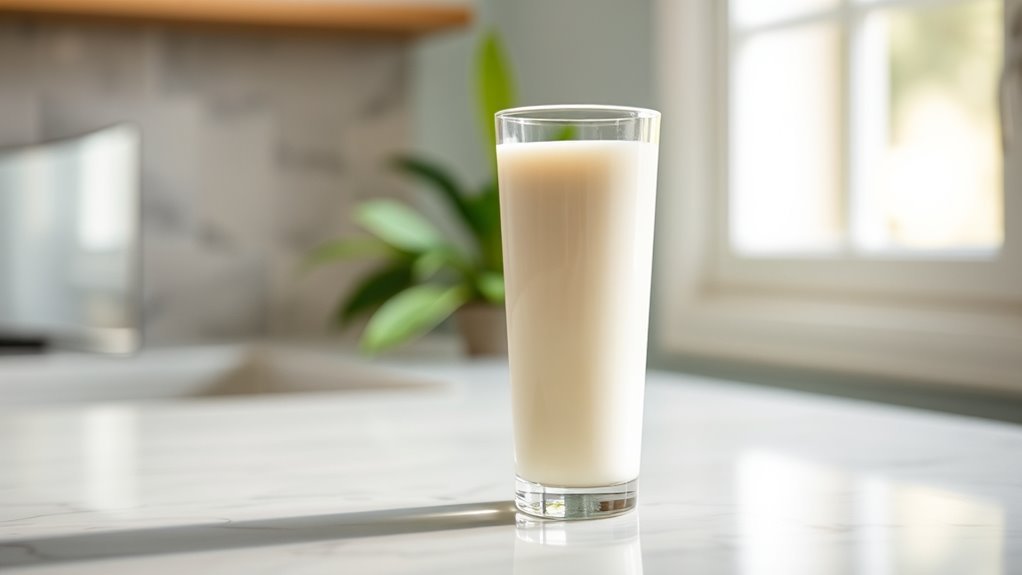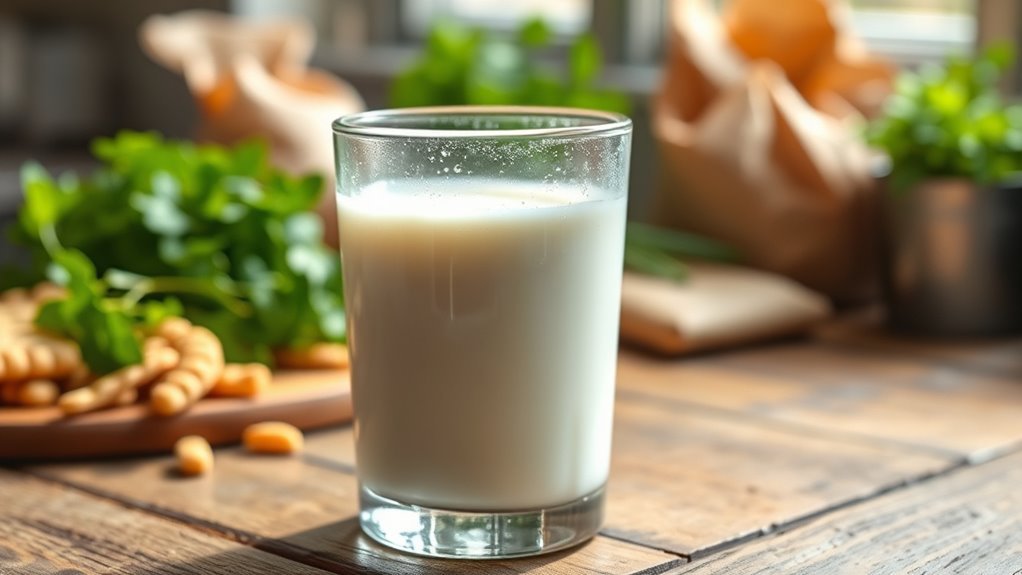Skim milk isn’t typically considered keto-friendly due to its higher carbohydrate content, which can disrupt ketosis. With 12 grams of carbs per cup, it may hinder your progress on a strict low-carb diet. While it offers benefits like calcium and protein, those consuming skim milk should be mindful of their carb limits. If you’re looking for better options, there are several alternatives that align more closely with keto principles. You might find some interesting choices worth exploring.
Understanding the Ketogenic Diet

When you immerse yourself in the ketogenic diet, it’s important to understand its fundamental principles. At its core, keto basics involve drastically reducing carbohydrate intake while increasing fats to shift your body into a state of ketosis. This metabolic state enables your body to burn fat for fuel instead of glucose. However, diet misconceptions often arise, leading to confusion. Some believe keto means unlimited fat intake, but portion control and nutritional quality matter too. Focus on healthy fats, moderate proteins, and low-carb vegetables for balanced nutrition. Remember, the goal isn’t just weight loss but also improved overall health. By grasping these principles, you can embrace the freedom and flexibility that the ketogenic lifestyle offers, tailored to your unique needs and preferences.
Nutritional Profile of Skim Milk

Understanding the nutritional profile of skim milk is key for those following a ketogenic diet. While it’s low in fat, it still packs a punch in essential nutrients. Here’s a quick look at its nutritional components:
| Nutrient | Amount per 1 cup | Benefits |
|---|---|---|
| Calcium | 302 mg | Supports bone health |
| Vitamin D | 2.5 µg | Enhances calcium absorption |
| Protein | 8 g | Aids muscle repair and growth |
| Carbohydrates | 12 g | Provides energy |
Skim milk offers a decent calcium content and various vitamins that can be beneficial. However, balancing these benefits with your carbohydrate intake is vital in a ketogenic lifestyle.
Carbohydrate Content and Its Effects on Ketosis

Carbohydrates play an essential role in determining whether you stay in ketosis, the metabolic state where your body burns fat for fuel instead of glucose. For those pursuing a keto lifestyle, understanding the carbohydrate impact of foods is imperative. Skim milk contains more carbohydrates than you might expect, mainly from lactose, which can hinder ketosis maintenance if consumed in excess. While it may fit into some meal plans, moderation is key. If you exceed your daily carb limit, your body may shift back to glucose for energy, disrupting your fat-burning state. To maintain ketosis effectively, consider alternative low-carb options that provide the freedom to enjoy your diet without compromising your goals. It’s all about balance and mindful choices.
Skim Milk vs. Whole Milk: A Comparison
While both skim milk and whole milk can be part of a balanced diet, their nutritional profiles differ markedly, which can impact your dietary choices, especially on a keto diet.
| Nutrient | Skim Milk Benefits | Whole Milk Drawbacks |
|---|---|---|
| Calories | Fewer calories | Higher calories |
| Fat Content | Low fat | High fat |
| Nutrients | More calcium, vitamins | Saturated fat content |
Skim milk provides benefits like lower calories and higher calcium, making it appealing if you’re watching your weight. However, whole milk’s higher fat content can be detrimental for some, potentially leading to excess calorie intake. Choosing between the two will depend on your specific dietary goals and lifestyle preferences.
Alternatives to Skim Milk for Keto Dieters
If you’re following a keto diet, you might find that skim milk doesn’t fit your macronutrient goals due to its higher carbohydrate content. Fortunately, there are several delicious alternatives that can keep you on track without sacrificing flavor:
- Nut Milk: Unsweetened almond and flax milk are low in carbs and rich in healthy fats.
- Coconut Cream: This is a great option for adding creaminess to coffee or desserts while keeping carbs low.
- Heavy Cream: With minimal carbs, it’s perfect for cooking or adding to your favorite recipes.
- Unsweetened Yogurt: Look for low-carb options that can be used in smoothies or as a snack.
With these choices, you can enjoy your meals without feeling restricted.
Incorporating Dairy Into a Keto Lifestyle
Incorporating dairy into a keto lifestyle can be both enjoyable and beneficial, as long as you choose the right products. Many dairy options can enhance your keto recipes while keeping your carb intake low. Here’s a quick guide to help you select the best dairy products:
| Dairy Option | Net Carbs (per 100g) |
|---|---|
| Heavy Cream | 3g |
| Cream Cheese | 4g |
| Full-Fat Greek Yogurt | 4g |
Opt for high-fat, low-carb choices like heavy cream and full-fat cheese. These can add flavor and richness to your meals without jeopardizing your ketosis. As you experiment with different dairy options, you’ll discover delicious ways to maintain your keto lifestyle while enjoying the creaminess of dairy.
Making Informed Choices for Your Keto Journey
When considering your keto journey, it’s essential to compare the nutritional profiles of foods, like skim milk versus higher-fat alternatives. Understanding the carbohydrate content and overall macros can help you make better choices aligned with your goals. Additionally, exploring options such as almond or coconut milk may provide suitable alternatives that fit more seamlessly into your diet.
Nutritional Profile Comparison
Understanding the nutritional profile of skim milk is essential for anyone maneuvering the keto diet. While it’s lower in fat content, it isn’t necessarily the best choice for your goals. Here’s a breakdown:
- Calories: Skim milk has about 83 calories per cup.
- Carbohydrates: It contains roughly 12 grams of carbs, which can impact your daily limit.
- Protein: You’ll find about 8 grams of protein, contributing to muscle maintenance.
- Nutrient Density: Skim milk is rich in vitamins and minerals, but the reduced fat can lead to lower nutrient absorption.
Considering these factors allows you to make informed choices that align with your keto journey, focusing on nutrient density while being mindful of your carb intake.
Alternatives to Skim Milk
If you’re looking for alternatives to skim milk on a keto diet, you’ve got several options that can better align with your low-carb goals. Almond milk is a popular choice; it’s low in carbs and calories, making it a great addition to smoothies or coffee. Just be sure to choose unsweetened varieties to keep sugar content in check. Another excellent option is coconut cream, which is rich in healthy fats and can add a creamy texture to your dishes or beverages. It’s higher in calories but fits nicely into a keto plan. Both options can give you the freedom to enjoy your favorite recipes while staying true to your dietary needs.
Frequently Asked Questions
Can I Drink Skim Milk on a Low-Carb Diet?
When you’re considering drinking skim milk on a low-carb diet, it’s important to look at its nutritional value. While skim milk has lower fat, it still contains carbohydrates—about 12 grams per cup. This carb content can add up quickly, depending on your daily allowance. You might want to balance it with other foods or opt for alternatives with fewer carbs, like unsweetened almond or coconut milk, to maintain your dietary goals.
Does Skim Milk Affect Blood Sugar Levels?
Skim milk can affect your blood sugar levels due to its lactose content, a natural sugar. When you consume it, your body releases insulin to manage this sugar, which can lead to fluctuations in blood sugar. While some people may tolerate it well, others might experience a more significant insulin response. It is crucial to monitor how your body reacts and consider alternatives if you’re aiming for stable blood sugar levels.
Is Lactose-Free Skim Milk Keto-Friendly?
When considering if lactose-free skim milk is keto-friendly, it’s important to evaluate its carb content. While it’s suitable for those with lactose intolerance, it still contains carbohydrates that can affect your ketosis. If you’re aiming for a strict ketogenic diet, exploring milk alternatives like almond or coconut milk might be a better choice. These options often have lower carbs, giving you more freedom to enjoy your meals without compromising your dietary goals.
How Does Skim Milk Impact Weight Loss on Keto?
“You can’t out-exercise a bad diet.” When it comes to weight loss on keto, skim milk can be tricky. While it’s lower in calories, it also contains lactose, which can affect your carb intake. If you’re not careful, those carbs might stall your progress. Instead, consider alternatives like unsweetened almond milk or heavy cream, which align better with keto. Balance is key, so make sure your choices support your weight loss goals.
Can Skim Milk Be Part of a Meal Prep for Keto?
When it comes to meal prep on a keto diet, incorporating skim milk can be a bit tricky. While it’s lower in fat, it still contains carbohydrates that can add up quickly. If you’re determined to include it, consider using it sparingly in recipes or as a flavoring agent. Always check your daily carb limits, and remember, balance is key. You’ve got the freedom to experiment, just stay mindful of those carbs!


